EDU30014: Health and Physical Education Assignment 2A Portfolio
VerifiedAdded on 2022/09/06
|5
|1441
|24
Portfolio
AI Summary
This portfolio assignment, created for the EDU30014 Health and Physical Education course, focuses on analyzing educational resources related to food and nutrition, specifically utilizing the 'Live Outside the Box' program. The assignment evaluates the resource's alignment with the Australian Curriculum, examining its lesson plans, pedagogical approaches, and technological aspects concerning student engagement. The analysis also considers methods for maintaining safe and challenging learning environments, as well as the resource's benefits and limitations, supported by academic literature. The portfolio highlights the importance of nutrition education and physical activity for Stage 3 children, emphasizing the need for engaging activities and parental involvement. The resource's strengths include curriculum compliance, while its limitations include a lack of focus on safety protocols. The assignment aims to provide a comprehensive understanding of effective teaching practices in health and physical education within a primary school setting.
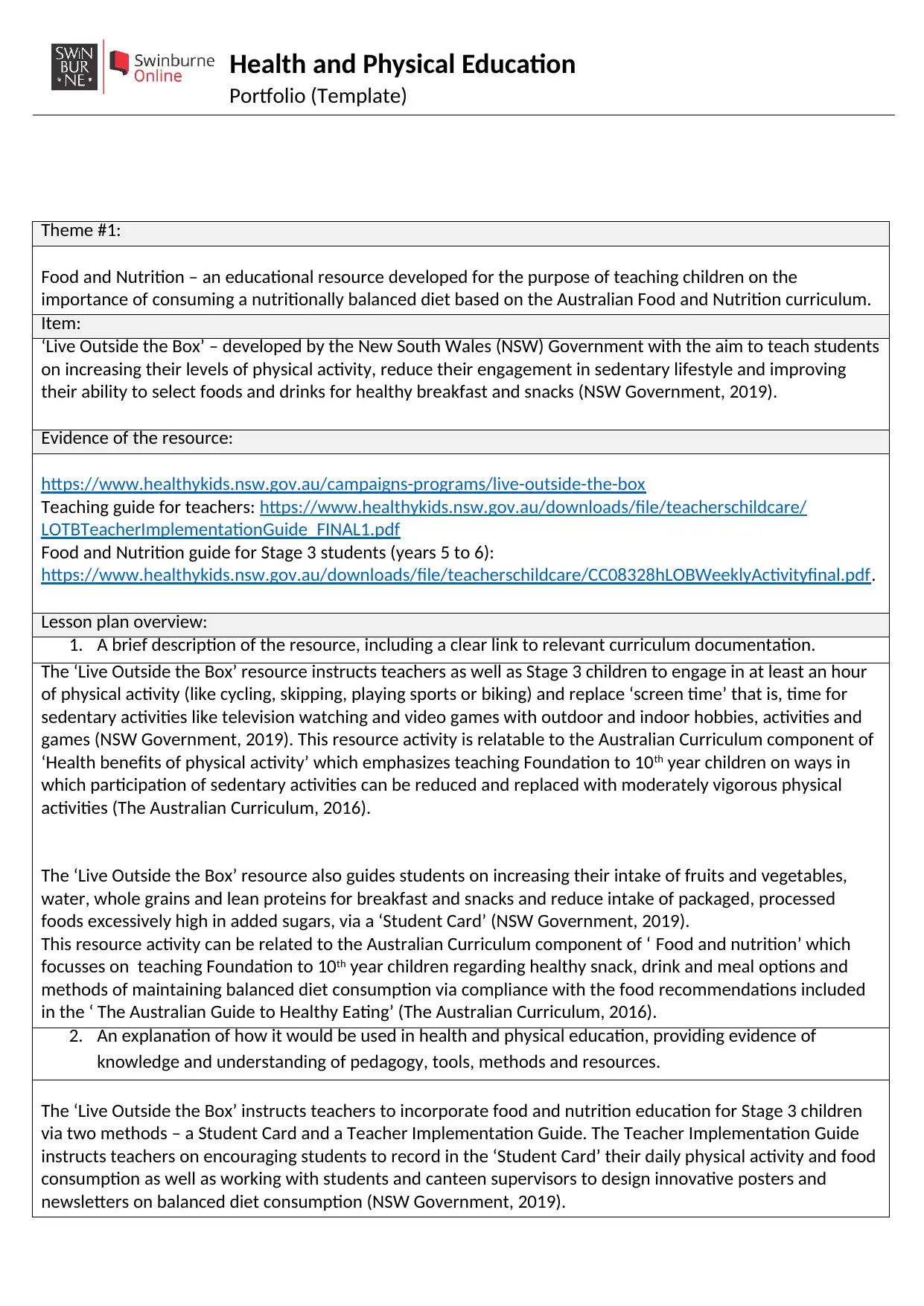
EDU30014: Health and Physical Education
Assignment 2A: Portfolio (Template)
Theme #1:
Food and Nutrition – an educational resource developed for the purpose of teaching children on the
importance of consuming a nutritionally balanced diet based on the Australian Food and Nutrition curriculum.
Item:
‘Live Outside the Box’ – developed by the New South Wales (NSW) Government with the aim to teach students
on increasing their levels of physical activity, reduce their engagement in sedentary lifestyle and improving
their ability to select foods and drinks for healthy breakfast and snacks (NSW Government, 2019).
Evidence of the resource:
https://www.healthykids.nsw.gov.au/campaigns-programs/live-outside-the-box
Teaching guide for teachers: https://www.healthykids.nsw.gov.au/downloads/file/teacherschildcare/
LOTBTeacherImplementationGuide_FINAL1.pdf
Food and Nutrition guide for Stage 3 students (years 5 to 6):
https://www.healthykids.nsw.gov.au/downloads/file/teacherschildcare/CC08328hLOBWeeklyActivityfinal.pdf.
Lesson plan overview:
1. A brief description of the resource, including a clear link to relevant curriculum documentation.
The ‘Live Outside the Box’ resource instructs teachers as well as Stage 3 children to engage in at least an hour
of physical activity (like cycling, skipping, playing sports or biking) and replace ‘screen time’ that is, time for
sedentary activities like television watching and video games with outdoor and indoor hobbies, activities and
games (NSW Government, 2019). This resource activity is relatable to the Australian Curriculum component of
‘Health benefits of physical activity’ which emphasizes teaching Foundation to 10th year children on ways in
which participation of sedentary activities can be reduced and replaced with moderately vigorous physical
activities (The Australian Curriculum, 2016).
The ‘Live Outside the Box’ resource also guides students on increasing their intake of fruits and vegetables,
water, whole grains and lean proteins for breakfast and snacks and reduce intake of packaged, processed
foods excessively high in added sugars, via a ‘Student Card’ (NSW Government, 2019).
This resource activity can be related to the Australian Curriculum component of ‘ Food and nutrition’ which
focusses on teaching Foundation to 10th year children regarding healthy snack, drink and meal options and
methods of maintaining balanced diet consumption via compliance with the food recommendations included
in the ‘ The Australian Guide to Healthy Eating’ (The Australian Curriculum, 2016).
2. An explanation of how it would be used in health and physical education, providing evidence of
knowledge and understanding of pedagogy, tools, methods and resources.
The ‘Live Outside the Box’ instructs teachers to incorporate food and nutrition education for Stage 3 children
via two methods – a Student Card and a Teacher Implementation Guide. The Teacher Implementation Guide
instructs teachers on encouraging students to record in the ‘Student Card’ their daily physical activity and food
consumption as well as working with students and canteen supervisors to design innovative posters and
newsletters on balanced diet consumption (NSW Government, 2019).
Assignment 2A: Portfolio (Template)
Theme #1:
Food and Nutrition – an educational resource developed for the purpose of teaching children on the
importance of consuming a nutritionally balanced diet based on the Australian Food and Nutrition curriculum.
Item:
‘Live Outside the Box’ – developed by the New South Wales (NSW) Government with the aim to teach students
on increasing their levels of physical activity, reduce their engagement in sedentary lifestyle and improving
their ability to select foods and drinks for healthy breakfast and snacks (NSW Government, 2019).
Evidence of the resource:
https://www.healthykids.nsw.gov.au/campaigns-programs/live-outside-the-box
Teaching guide for teachers: https://www.healthykids.nsw.gov.au/downloads/file/teacherschildcare/
LOTBTeacherImplementationGuide_FINAL1.pdf
Food and Nutrition guide for Stage 3 students (years 5 to 6):
https://www.healthykids.nsw.gov.au/downloads/file/teacherschildcare/CC08328hLOBWeeklyActivityfinal.pdf.
Lesson plan overview:
1. A brief description of the resource, including a clear link to relevant curriculum documentation.
The ‘Live Outside the Box’ resource instructs teachers as well as Stage 3 children to engage in at least an hour
of physical activity (like cycling, skipping, playing sports or biking) and replace ‘screen time’ that is, time for
sedentary activities like television watching and video games with outdoor and indoor hobbies, activities and
games (NSW Government, 2019). This resource activity is relatable to the Australian Curriculum component of
‘Health benefits of physical activity’ which emphasizes teaching Foundation to 10th year children on ways in
which participation of sedentary activities can be reduced and replaced with moderately vigorous physical
activities (The Australian Curriculum, 2016).
The ‘Live Outside the Box’ resource also guides students on increasing their intake of fruits and vegetables,
water, whole grains and lean proteins for breakfast and snacks and reduce intake of packaged, processed
foods excessively high in added sugars, via a ‘Student Card’ (NSW Government, 2019).
This resource activity can be related to the Australian Curriculum component of ‘ Food and nutrition’ which
focusses on teaching Foundation to 10th year children regarding healthy snack, drink and meal options and
methods of maintaining balanced diet consumption via compliance with the food recommendations included
in the ‘ The Australian Guide to Healthy Eating’ (The Australian Curriculum, 2016).
2. An explanation of how it would be used in health and physical education, providing evidence of
knowledge and understanding of pedagogy, tools, methods and resources.
The ‘Live Outside the Box’ instructs teachers to incorporate food and nutrition education for Stage 3 children
via two methods – a Student Card and a Teacher Implementation Guide. The Teacher Implementation Guide
instructs teachers on encouraging students to record in the ‘Student Card’ their daily physical activity and food
consumption as well as working with students and canteen supervisors to design innovative posters and
newsletters on balanced diet consumption (NSW Government, 2019).
Paraphrase This Document
Need a fresh take? Get an instant paraphrase of this document with our AI Paraphraser
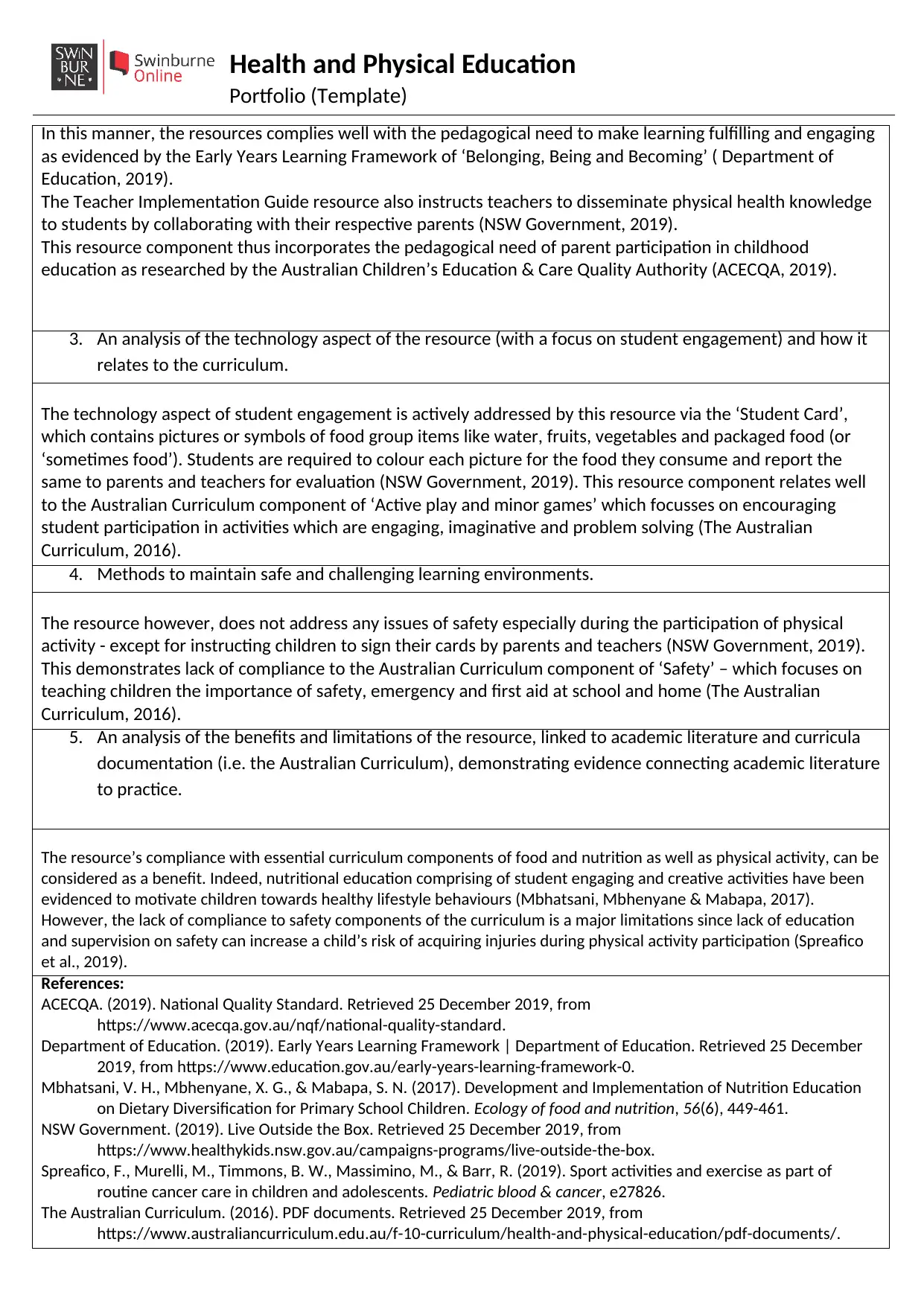
EDU30014: Health and Physical Education
Assignment 2A: Portfolio (Template)
In this manner, the resources complies well with the pedagogical need to make learning fulfilling and engaging
as evidenced by the Early Years Learning Framework of ‘Belonging, Being and Becoming’ ( Department of
Education, 2019).
The Teacher Implementation Guide resource also instructs teachers to disseminate physical health knowledge
to students by collaborating with their respective parents (NSW Government, 2019).
This resource component thus incorporates the pedagogical need of parent participation in childhood
education as researched by the Australian Children’s Education & Care Quality Authority (ACECQA, 2019).
3. An analysis of the technology aspect of the resource (with a focus on student engagement) and how it
relates to the curriculum.
The technology aspect of student engagement is actively addressed by this resource via the ‘Student Card’,
which contains pictures or symbols of food group items like water, fruits, vegetables and packaged food (or
‘sometimes food’). Students are required to colour each picture for the food they consume and report the
same to parents and teachers for evaluation (NSW Government, 2019). This resource component relates well
to the Australian Curriculum component of ‘Active play and minor games’ which focusses on encouraging
student participation in activities which are engaging, imaginative and problem solving (The Australian
Curriculum, 2016).
4. Methods to maintain safe and challenging learning environments.
The resource however, does not address any issues of safety especially during the participation of physical
activity - except for instructing children to sign their cards by parents and teachers (NSW Government, 2019).
This demonstrates lack of compliance to the Australian Curriculum component of ‘Safety’ – which focuses on
teaching children the importance of safety, emergency and first aid at school and home (The Australian
Curriculum, 2016).
5. An analysis of the benefits and limitations of the resource, linked to academic literature and curricula
documentation (i.e. the Australian Curriculum), demonstrating evidence connecting academic literature
to practice.
The resource’s compliance with essential curriculum components of food and nutrition as well as physical activity, can be
considered as a benefit. Indeed, nutritional education comprising of student engaging and creative activities have been
evidenced to motivate children towards healthy lifestyle behaviours (Mbhatsani, Mbhenyane & Mabapa, 2017).
However, the lack of compliance to safety components of the curriculum is a major limitations since lack of education
and supervision on safety can increase a child’s risk of acquiring injuries during physical activity participation (Spreafico
et al., 2019).
References:
ACECQA. (2019). National Quality Standard. Retrieved 25 December 2019, from
https://www.acecqa.gov.au/nqf/national-quality-standard.
Department of Education. (2019). Early Years Learning Framework | Department of Education. Retrieved 25 December
2019, from https://www.education.gov.au/early-years-learning-framework-0.
Mbhatsani, V. H., Mbhenyane, X. G., & Mabapa, S. N. (2017). Development and Implementation of Nutrition Education
on Dietary Diversification for Primary School Children. Ecology of food and nutrition, 56(6), 449-461.
NSW Government. (2019). Live Outside the Box. Retrieved 25 December 2019, from
https://www.healthykids.nsw.gov.au/campaigns-programs/live-outside-the-box.
Spreafico, F., Murelli, M., Timmons, B. W., Massimino, M., & Barr, R. (2019). Sport activities and exercise as part of
routine cancer care in children and adolescents. Pediatric blood & cancer, e27826.
The Australian Curriculum. (2016). PDF documents. Retrieved 25 December 2019, from
https://www.australiancurriculum.edu.au/f-10-curriculum/health-and-physical-education/pdf-documents/.
Assignment 2A: Portfolio (Template)
In this manner, the resources complies well with the pedagogical need to make learning fulfilling and engaging
as evidenced by the Early Years Learning Framework of ‘Belonging, Being and Becoming’ ( Department of
Education, 2019).
The Teacher Implementation Guide resource also instructs teachers to disseminate physical health knowledge
to students by collaborating with their respective parents (NSW Government, 2019).
This resource component thus incorporates the pedagogical need of parent participation in childhood
education as researched by the Australian Children’s Education & Care Quality Authority (ACECQA, 2019).
3. An analysis of the technology aspect of the resource (with a focus on student engagement) and how it
relates to the curriculum.
The technology aspect of student engagement is actively addressed by this resource via the ‘Student Card’,
which contains pictures or symbols of food group items like water, fruits, vegetables and packaged food (or
‘sometimes food’). Students are required to colour each picture for the food they consume and report the
same to parents and teachers for evaluation (NSW Government, 2019). This resource component relates well
to the Australian Curriculum component of ‘Active play and minor games’ which focusses on encouraging
student participation in activities which are engaging, imaginative and problem solving (The Australian
Curriculum, 2016).
4. Methods to maintain safe and challenging learning environments.
The resource however, does not address any issues of safety especially during the participation of physical
activity - except for instructing children to sign their cards by parents and teachers (NSW Government, 2019).
This demonstrates lack of compliance to the Australian Curriculum component of ‘Safety’ – which focuses on
teaching children the importance of safety, emergency and first aid at school and home (The Australian
Curriculum, 2016).
5. An analysis of the benefits and limitations of the resource, linked to academic literature and curricula
documentation (i.e. the Australian Curriculum), demonstrating evidence connecting academic literature
to practice.
The resource’s compliance with essential curriculum components of food and nutrition as well as physical activity, can be
considered as a benefit. Indeed, nutritional education comprising of student engaging and creative activities have been
evidenced to motivate children towards healthy lifestyle behaviours (Mbhatsani, Mbhenyane & Mabapa, 2017).
However, the lack of compliance to safety components of the curriculum is a major limitations since lack of education
and supervision on safety can increase a child’s risk of acquiring injuries during physical activity participation (Spreafico
et al., 2019).
References:
ACECQA. (2019). National Quality Standard. Retrieved 25 December 2019, from
https://www.acecqa.gov.au/nqf/national-quality-standard.
Department of Education. (2019). Early Years Learning Framework | Department of Education. Retrieved 25 December
2019, from https://www.education.gov.au/early-years-learning-framework-0.
Mbhatsani, V. H., Mbhenyane, X. G., & Mabapa, S. N. (2017). Development and Implementation of Nutrition Education
on Dietary Diversification for Primary School Children. Ecology of food and nutrition, 56(6), 449-461.
NSW Government. (2019). Live Outside the Box. Retrieved 25 December 2019, from
https://www.healthykids.nsw.gov.au/campaigns-programs/live-outside-the-box.
Spreafico, F., Murelli, M., Timmons, B. W., Massimino, M., & Barr, R. (2019). Sport activities and exercise as part of
routine cancer care in children and adolescents. Pediatric blood & cancer, e27826.
The Australian Curriculum. (2016). PDF documents. Retrieved 25 December 2019, from
https://www.australiancurriculum.edu.au/f-10-curriculum/health-and-physical-education/pdf-documents/.
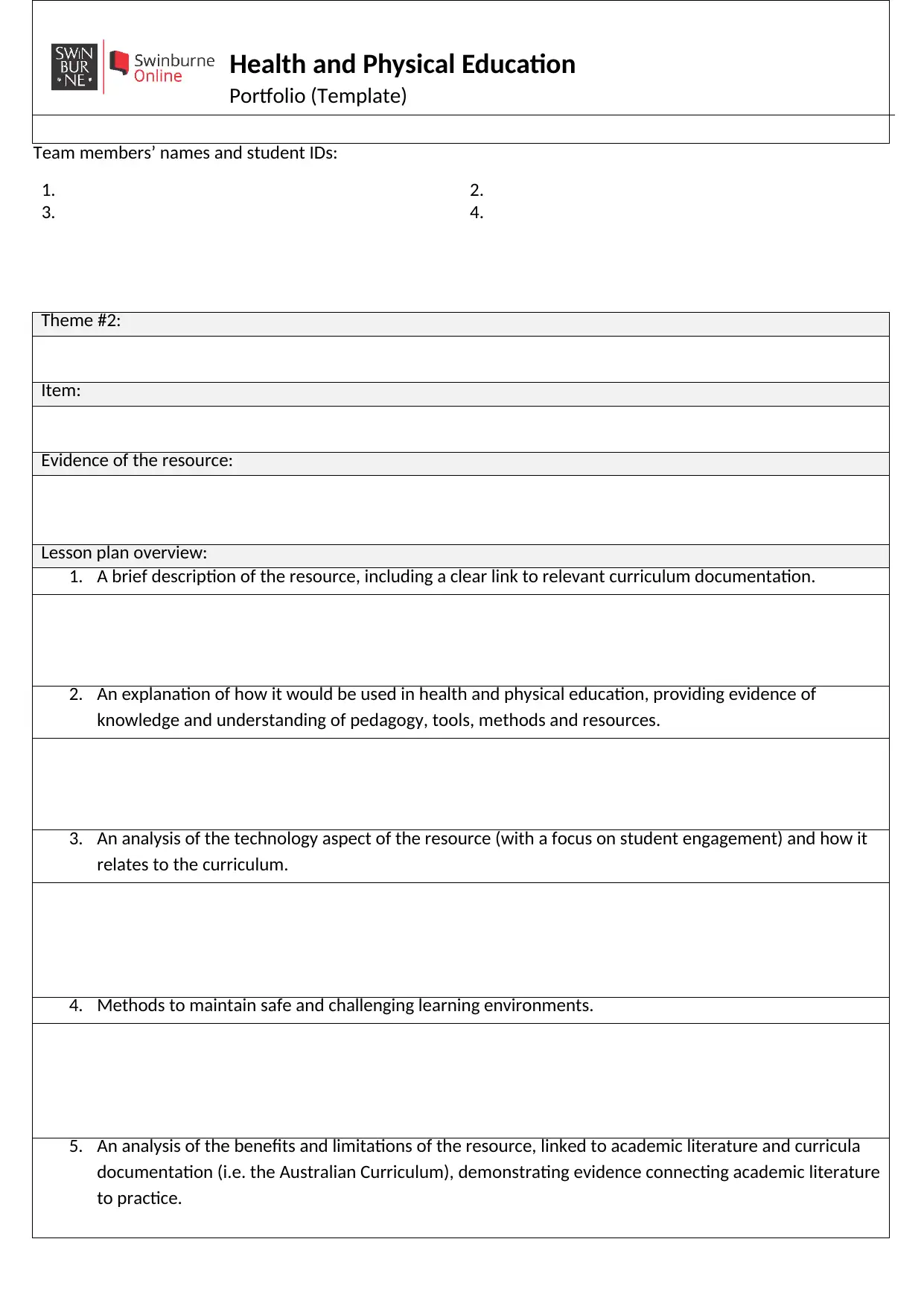
EDU30014: Health and Physical Education
Assignment 2A: Portfolio (Template)
Team members’ names and student IDs:
1. 2.
3. 4.
Theme #2:
Item:
Evidence of the resource:
Lesson plan overview:
1. A brief description of the resource, including a clear link to relevant curriculum documentation.
2. An explanation of how it would be used in health and physical education, providing evidence of
knowledge and understanding of pedagogy, tools, methods and resources.
3. An analysis of the technology aspect of the resource (with a focus on student engagement) and how it
relates to the curriculum.
4. Methods to maintain safe and challenging learning environments.
5. An analysis of the benefits and limitations of the resource, linked to academic literature and curricula
documentation (i.e. the Australian Curriculum), demonstrating evidence connecting academic literature
to practice.
Assignment 2A: Portfolio (Template)
Team members’ names and student IDs:
1. 2.
3. 4.
Theme #2:
Item:
Evidence of the resource:
Lesson plan overview:
1. A brief description of the resource, including a clear link to relevant curriculum documentation.
2. An explanation of how it would be used in health and physical education, providing evidence of
knowledge and understanding of pedagogy, tools, methods and resources.
3. An analysis of the technology aspect of the resource (with a focus on student engagement) and how it
relates to the curriculum.
4. Methods to maintain safe and challenging learning environments.
5. An analysis of the benefits and limitations of the resource, linked to academic literature and curricula
documentation (i.e. the Australian Curriculum), demonstrating evidence connecting academic literature
to practice.
⊘ This is a preview!⊘
Do you want full access?
Subscribe today to unlock all pages.

Trusted by 1+ million students worldwide
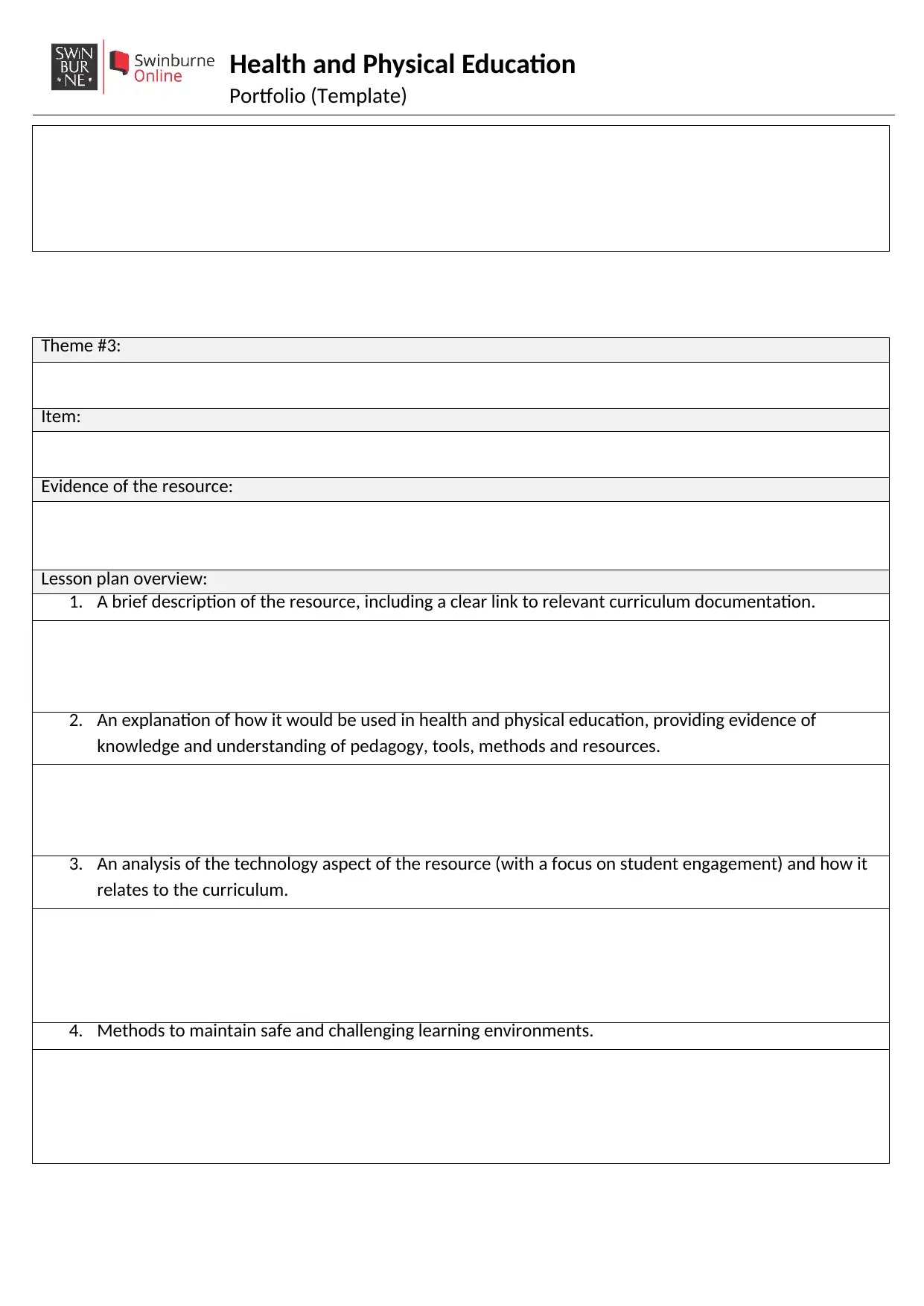
EDU30014: Health and Physical Education
Assignment 2A: Portfolio (Template)
Theme #3:
Item:
Evidence of the resource:
Lesson plan overview:
1. A brief description of the resource, including a clear link to relevant curriculum documentation.
2. An explanation of how it would be used in health and physical education, providing evidence of
knowledge and understanding of pedagogy, tools, methods and resources.
3. An analysis of the technology aspect of the resource (with a focus on student engagement) and how it
relates to the curriculum.
4. Methods to maintain safe and challenging learning environments.
Assignment 2A: Portfolio (Template)
Theme #3:
Item:
Evidence of the resource:
Lesson plan overview:
1. A brief description of the resource, including a clear link to relevant curriculum documentation.
2. An explanation of how it would be used in health and physical education, providing evidence of
knowledge and understanding of pedagogy, tools, methods and resources.
3. An analysis of the technology aspect of the resource (with a focus on student engagement) and how it
relates to the curriculum.
4. Methods to maintain safe and challenging learning environments.
Paraphrase This Document
Need a fresh take? Get an instant paraphrase of this document with our AI Paraphraser
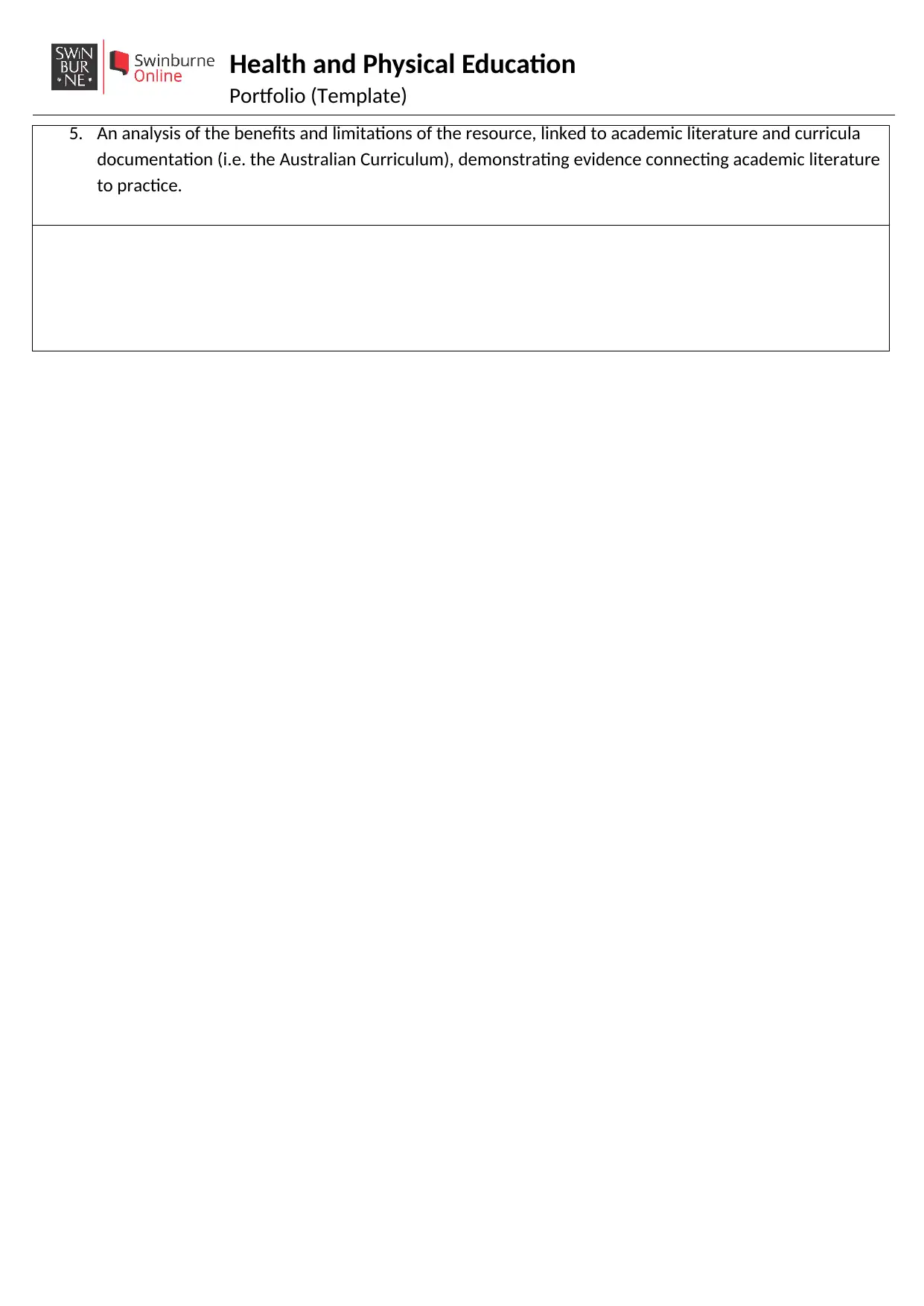
EDU30014: Health and Physical Education
Assignment 2A: Portfolio (Template)
5. An analysis of the benefits and limitations of the resource, linked to academic literature and curricula
documentation (i.e. the Australian Curriculum), demonstrating evidence connecting academic literature
to practice.
Assignment 2A: Portfolio (Template)
5. An analysis of the benefits and limitations of the resource, linked to academic literature and curricula
documentation (i.e. the Australian Curriculum), demonstrating evidence connecting academic literature
to practice.
1 out of 5
Related Documents
Your All-in-One AI-Powered Toolkit for Academic Success.
+13062052269
info@desklib.com
Available 24*7 on WhatsApp / Email
![[object Object]](/_next/static/media/star-bottom.7253800d.svg)
Unlock your academic potential
Copyright © 2020–2025 A2Z Services. All Rights Reserved. Developed and managed by ZUCOL.





